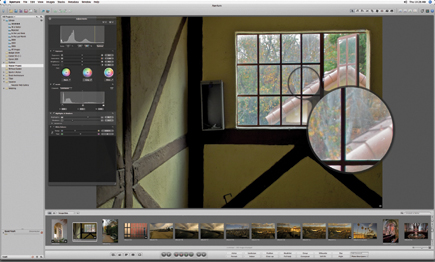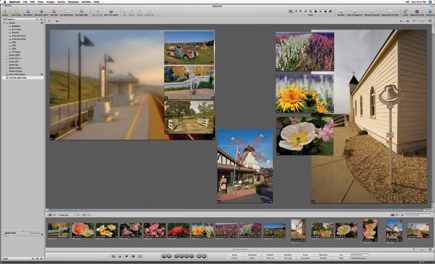Apple’s Aperture; Digital Camera Image Management, Processing, Editing, And Output—All In One Page 2
With most other raw software converters and programs, once an image is adjusted you had to then export it and open that file in an image editor to do anything with it. But Aperture continues to provide the tools a photographer needs to further organize, present, and publish photographs in formats applicable to a variety of tasks without this extra step. For example, if a photographer wants to output a digital slide show either from some of the images in a Project or images from several different Projects, a Smart Album can be created and the images can be gathered as a collection in this new Smart Album space. Smart Albums, unlike the Project albums, allow images to be controlled and gathered via the Query HUD. Any applied criteria can be used to gather images, including star ratings, keywords, etc.
Eyedropper And Loupe |
|
 |
|
|
Another organizational space is Light Table, a freeform space for arranging
slides on a virtual light table that also allows you to re-size and overlay
images. Images can be added to a newly created Light Table from any project
or album browser by just dragging the image into the Light Table's work
space on screen. That selection can be individually re-sized and further adjusted
so the values match other images in the Light Table collection. It's very
much like a page in a desktop publishing program, but even easier to use.
The output options provided by Aperture support all kinds of media, from the
web and e-mail to high-quality bound books printed through services from Apple,
available via their online Aperture service. The single image print is effectively
done with a print dialog that supports a preview for sizing and, if desired,
putting a border on the image on the print. It is fully color managed to print
directly to a print space profile, with Aperture controlling color. And of course
individual images can be exported as files saved to your desktop or a folder,
or opened in a designated application like Photoshop. Additionally, copies of
the downloaded raw format camera files can be output intact in their native
raw format.
Both web journals (photoblogs) and web galleries may be created using Aperture-controlled
formatting for the number of columns/thumbnail size and the number of rows and,
with Journals, support for text in text blocks. And, of course images in a browser
can be selected to be included in a contact proof sheet that may be reproduced
with a desktop printer, output as an Acrobat .PDF, sent as e-mail or reproduced
in HTML as a web page. Finally, Aperture supports multi-paged books using a
Create Book Album from a selection of images. The book can be reproduced in
different sizes and styles, which you can first proof with a desktop printer
and then order through Apple online, including binding in hard or soft cover.
This strikes me as a real bonus for a wedding photographer, as Aperture supports
the entire process from start to a finished album.
While Aperture is designed around the photographer's needs when working
with a digital camera, it is not limited to working with current images only
from a digital camera. It will support opening and processing raw scan files
in the same manner, with all the tools available as well. It will also open
and incorporate all standard image format files from CD-Rs and other media from
a library of photographs, so you may mix and match images from all sources both
old and new to output from Aperture in all the formats it supports.
Light Table |
|
 |
|
|
Evaluation And Recommendation
It was an ambitious undertaking for Apple to produce an entirely new application
that would address all of the primary software needs of photographers in one
integrated work space. That Aperture is as comprehensive as it is, and functions
as fast and efficiently to produce high-quality results with relative ease is
pretty miraculous. Their accomplishment is even more impressive given that this
is their first go-round; other software vendors have been doing image-editing
applications for years and have achieved their effectiveness only over years
of numerous version upgrades.
Indeed, some of the Aperture capabilities are already available in LaserSoft's
SilverFast DCPro Studio, but that program is a long way from having the slick
and elegant interface Aperture provides. Aperture does have its faults. There
are needed but missing tools. The one most serious flaw for me is that Aperture
relies too heavily on keyboard short cuts; in fact, pages of them. Keyboard
short cuts are an efficiency advantage for someone using just one or at most
two major applications, but not if you regularly use a dozen unrelated applications
like a database, spreadsheet, Internet browser, e-mail, word processor, layout
and design application for DTP, plus a sophisticated creative paint application.
It's simply far too much to memorize. Apple would be wise to offer many
more right mouse button context sensitive menu selections in addition to their
keyboard short cuts. Another suggestion is that the Adjustment HUD should also
offer an HSL selective color adjustment tool, as well as a filter to eliminate
color fringe artifacts from very short, wide angle lenses.
Although $499 is a substantial software investment, the breadth and capabilities
of Aperture makes it worthwhile. There has been some talk that you need a super
powerful Mac to run it, but from my experience I think the horsepower of a G5
Quad is only required by very prolific pro shooters doing 1000 exposures a day
or more. It worked fine, efficiently and faster than any other digital camera
raw file application I've used on a year-old minimally configured G5,
and the published minimum requirements include both Mac PowerBooks and the latest
model iMacs (the new Intel Dual Core will be supported by the time you read
this). You can be sure I will continue to use Aperture on a regular basis, and
I can't really imagine a photographer not finding it a great advantage
in speed, efficiency, quality, and capability.
Aperture Version 1.1
As we went to press Apple announced Version 1.1 of Aperture, a major upgrade
based on user feedback. The upgrade is the first Universal version of Aperture
and is available free to all registered Aperture owners. According to Apple,
Aperture 1.1 provides new, improved raw decode algorithms that deliver next-generation
raw image handling. Thanks to the improved default rendering of raw images from
supported cameras, Aperture 1.1 is said to yield significantly better image
quality in noise reduction, sharpening, and highlight recovery.
In order to maintain the image integrity of the existing photos in your Aperture
library, Aperture 1.1 gives you the ability to retain the original 1.0 raw decode.
Or, if you prefer, you can selectively migrate images to the new 1.1 raw decode.
Also new is Raw Fine Tuning, an entirely new set of Raw Fine Tuning controls
available in the Adjustments HUD allowing you to tweak decode settings. These
include Boost, which lets you intensify or reduce image contrast; Sharpening,
which lets you either dial in the amount of sharpening you'd prefer to
see applied to images in the raw decode process or turn off sharpening altogether;
and Chroma Blur, which lets you soften chroma noise by blurring color artifacts
caused by camera sensor noise. Aperture 1.1 lets you save your customized decode
adjustments as a camera default, so they can be easily applied to newly imported
images.
Designed specifically to deal with noisy images resulting from high ISOs or
long exposures, Aperture 1.1's new Auto Noise Compensation option automatically
applies the optimal settings for noise reduction to your image. A real time-saver,
Auto Noise Compensation takes into account the unique noise characteristics
of each camera and dials in the optimal settings to produce a high-quality result.
Aperture 1.1 includes a built-in color meter you can use to sample the pixel
values anywhere in an image and display them in RGB, LAB, or CMYK. Particularly
useful when fine-tuning image exposure, color balance, and brightness parameters,
you can use the color meter anywhere in Aperture--while editing, adjusting,
arranging images on a Light Table, or laying out a book. In Aperture 1.1, you
can display color values at any time in the Adjustments HUD or opt to display
them right in the Loupe.
In Aperture 1.1 the Export Versions command now includes a "Fit Within
(Inches)" option and allows you to specify a resolution in dots per inch
(dpi) for exported images, making it easier to output images at exactly the
size you want. In addition, you can also specify the default dpi for images
you'd like to open in an external editor. If, for example, you regularly
open images for layering effects in Adobe Photoshop, you can now specify that
Photoshop open them at 300dpi (or another dpi of your choosing). Aperture 1.1
now allows you to manage layered Photoshop files without having to needlessly
create additional flattened versions.
For more information and detailed computer requirements (pay particular attention
to which video cards are supported), visit the Apple website at: http://apple.com/aperture.
You may also contact Apple Computer, Inc. at 1 Infinite Loop, Cupertino, CA
95014; (408) 996-1010.
- Log in or register to post comments

































